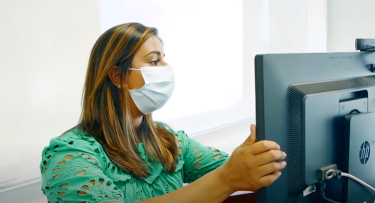
Mercy College faculty responded to the COVID-19 pandemic quickly and nimbly to best support students. When the College closed in March, faculty members had to shift their classes online, and President Hall praised them for embracing this unprecedented challenge “without skipping a beat.”
Now, as Mercy heads into the fall term, faculty members are once again stepping up to ensure that students can continue with their education. To enable students to learn in a mode that is most comfortable for their individual preferences, Mercy is offering students the options of taking classes in person, entirely online, or in a hybrid format called blended learning, in which a live class is held both in person and online at the same time. In the hybrid format, students can choose how they would like to participate. In planning for the fall, deans and department heads decided which classes were the highest priority to meet in person, which ones could be offered online without affecting the quality of instruction, and which ones were better suited to the blended learning format.
Blended learning is a first for the College, but as usual, the faculty is tackling the challenge head on. Because Mercy already has a dedicated team that supports fully online instruction, the Center for Teaching and Learning (the Center) has been focused on preparing training tools to ensure that faculty members can teach using the blended learning model. These tools include a series of workshops to train them on this new pedagogical practice as well as a dedicated faculty resource page on the website.
“It’s a new experience for most faculty members to have a blended classroom,” explained Mitchell Fried, Ph.D., the Center’s interim director. Therefore, the workshops cover a range of topics such as how to use Zoom, how to design classrooms for blended learning, how to incorporate multimedia tools, how to engage students in new ways, and how to work both with students who are on Zoom and those who are in the classroom during the same class session. To date, over 500 faculty members have attended one of these workshops.
“What we stress is that the pedagogy and expertise of the faculty remain intact,” explained Juli Steadman Charkes, instructional designer at the Center. “What we're providing in these trainings are some instructional design principles, some suggestions, some technology training that just support what’s already there: the expertise, the pedagogy, and the willingness to create a learning environment in which students succeed. Rather than technology driving the bus, the technology supports what's already there.”
In order to prepare for blended learning, Mercy has made extensive technology upgrades in classrooms since the spring. “Mercy's commitment to continued learning is clear with the technology investment of these blended classrooms,” said Fried. “Across all campuses, we now have learning environments that allow for multiple teaching modalities, including the blended/hyflex model. Positioned cameras will capture teaching and make this available for different cohorts. The result is a high-level of learning continuity, regardless of outside circumstances.”
Mercy’s decisions about how to reopen were heavily informed by the results of a survey sent to students early in the summer. "We surveyed students, they told us what they want, we listened, and now the faculty is working diligently to meet those needs," said José Herrera, Ph.D., Mercy’s Provost and Vice President of Academic Affairs.
Of the 1,811 students who responded to the survey, 33% indicated a preference for completing all of their coursework online, 25% indicated a preference for completing all of their coursework in person, and the rest preferred coursework to be completed partly online and partly in person. Students now have those options, depending on which courses they take. In sharing their preferences for a hybrid option, the majority of students (51%) preferred an option in which classes are taught both in person and online by the same instructor at the same time with students making the choice about how to attend. Mercy took students’ preferences seriously, making this the hybrid option for the fall semester.
Patrick Fazioli, Ph.D., associate professor in the School of Liberal Arts’ Department of Humanities and co-director of the Global Honors Program, is one of the faculty members teaching blended learning classes this fall. “One of the things I've been looking at is which material can be moved most seamlessly online,” he said. “This is something that I haven't really had to confront before because normally we would have enough seat time where I can teach it all in person. Now that time is a bit more precious, I'm trying to figure out what is the high priority content that we must discuss in person and what is the content that we can move online asynchronously.”
Steadman Charkes – who teaches classes as well – is excited about the challenge. “I am one of many instructors who absolutely thrives on the energy in the live environment. But I volunteered for a blended classroom. I believe that a blended classroom can work with a little bit more effort and a little bit more thinking through. I'm curious and eager to try it.”
In addition to offering blended learning for the first time, faculty members are preparing to take their classes entirely online if COVID-19 mandates that course of action. While the year ahead is uncertain, what is known is that Mercy’s faculty are dedicated and prepared to ensure that students can continue their education uninterrupted.
